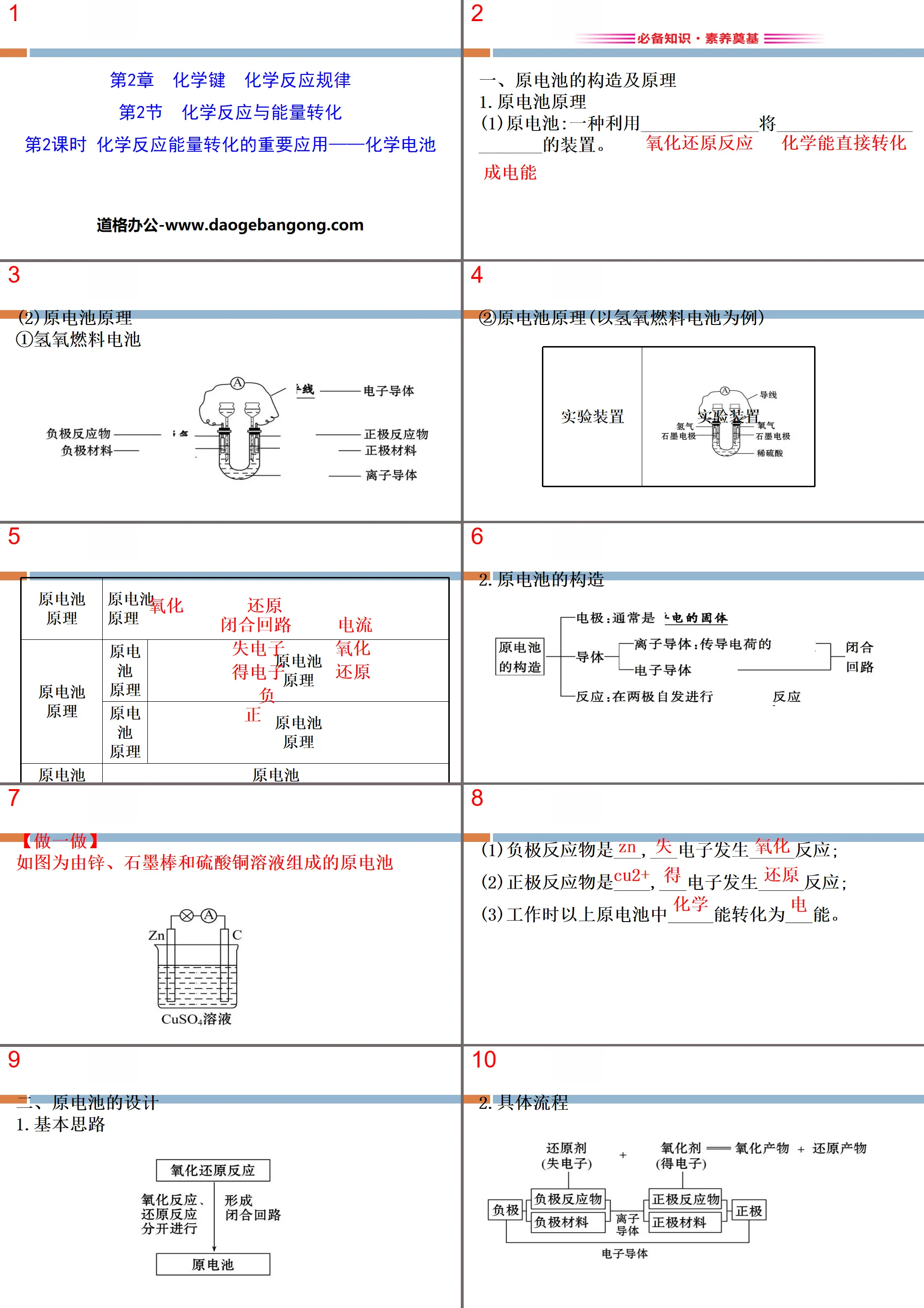People's Education Press High School Chemistry Compulsory Course I
Cantonese Education Edition Ninth Grade Chemistry Volume 1
People's Education Press Ninth Grade Chemistry Volume 1
Beijing Curriculum Reform Edition Ninth Grade Chemistry Volume 1
Beijing Curriculum Reform Edition Ninth Grade Chemistry Volume 2
Lu Jiao Edition Ninth Grade Chemistry Volume 1
Lu Ke Edition High School Chemistry Compulsory Course 1
Cantonese Education Edition Ninth Grade Chemistry Volume 2
Hunan Education Edition Ninth Grade Chemistry Volume 1
People's Education Press Ninth Grade Chemistry Volume 2
People's Education Press High School Chemistry Compulsory Course 2
Lu Ke Edition High School Chemistry Compulsory Course 2
Hunan Education Edition Ninth Grade Chemistry Volume 2
Lu Jiao Edition Ninth Grade Chemistry Volume 2

| Category | Format | Size |
|---|---|---|
| Lu Ke Edition High School Chemistry Compulsory Course 2 | pptx | 6 MB |
Description
"Chemical Reactions and Energy Transformation" Chemical Bonding and Chemical Reaction Laws PPT (Lesson 2)
Part 1: Essential knowledge and foundation of literacy
1. Structure and principle of primary battery
1.Principle of primary battery
(1) Primary battery: A device that uses ____________________ to ____________________.
(2)Principle of primary battery
①Hydrogen-oxygen fuel cell
②Principle of primary battery (taking hydrogen-oxygen fuel cell as an example)
2. Structure of primary battery
【Do it】
The picture shows a galvanic battery composed of zinc, graphite rods and copper sulfate solution.
(1) The negative reactant is ___, and ___ electrons react _____;
(2) The positive reactant is ____, ___ electrons undergo _____ reaction;
(3) When working, the _____ energy in the above primary battery is converted into ___ energy.
2. Design of primary battery
1.Basic idea
2. Specific process
3.Examples
(1) Primary battery design
(2)Device
①Device
②Electrode reaction
Negative reaction: ______________, _____ reaction;
Positive reaction: 2H++2e-====H2↑, reduction reaction.
【Smart Judgment】
(1) In the primary battery, electrons travel from the negative electrode through the wire to the positive electrode, and then from the positive electrode through the solution to the negative electrode, forming a closed loop. ()
Tip:×. When conducting electricity, there is no movement of electrons in the solution, only directional movement of anions and cations.
(2) If both electrodes in the primary battery are metal, generally an active metal will be used as the negative electrode. ()
Tips:√. Active metals easily lose electrons, and the pole that loses electrons in a primary battery is the negative electrode.
Chemical Reaction and Energy Conversion PPT, Part 2: Key Competencies·Quality Foundation
Knowledge point 1: The principle of primary battery and electrode judgment
[Key points to clarify doubts]
1. Principle (taking copper-zinc primary battery as an example)
2. Judgment of positive and negative poles
[Error-prone reminder] Several issues that should be paid attention to when judging the positive and negative poles
(1) The one with strong activity is not necessarily the negative electrode. For example, magnesium and aluminum are put into sodium hydroxide solution to form a primary battery, and aluminum is the negative electrode; copper and aluminum are put into concentrated nitric acid to form a primary battery. Due to the passivation of aluminum, copper It's the negative pole.
(2) The electrodes in the fuel cell do not participate in the reaction. One pole where the fuel is fed is the negative electrode, and the other pole where the combustion accelerant (usually oxygen) is fed is the positive electrode.
(3) If a battery reaction is given, the positive and negative electrodes can also be judged based on the change in valence. The substance with increased valence loses electrons and is the negative electrode; the substance with decreased valence gains electrons and is the positive electrode.
【Think·Discussion】
(1) What is the meaning of "closed loop" in the primary battery principle?
Tip: When the primary battery is working, the charged particles move in a certain direction according to certain rules. It should be grasped from two aspects: first, the anions in the solution move toward the negative electrode, while the cations move toward the positive electrode; Electrons flow from the negative electrode to the positive electrode (current flows from the positive electrode to the negative electrode). Particles with the same charge throughout the loop are constantly moving in one direction.
(2) Can the negative electrode of a battery only be made of metal?
Hint: No. The negative electrode of a fuel cell is not a metal. For example, the negative electrode material of a hydrogen-oxygen fuel cell is graphite.
【Case Demonstration】
[Typical example] (2019·Linyi Senior High School Test) As shown in the picture is a primary battery formed by Zn and Cu. After an experimental interest group completed the experiment, the record on the reading card was as follows. The description on the card is reasonable: ()
A.①②③ B.②④ C.②③④ D.③④⑤
[Thinking Modeling] The thinking process for answering the primary battery principle test questions is as follows:
[Analysis] Choose B. When copper and zinc form a primary battery, zinc is the negative electrode and copper is the positive electrode; as zinc loses electrons and becomes zinc ions into the solution, the electrons flow to the positive electrode through the external circuit, and the hydrogen ions in the solution gain electrons on the positive electrode and become hydrogen gas. A reduction reaction occurs; cations move to the positive electrode, and anionic sulfate ions move to the negative electrode; if 0.5 mol of electrons flows through the wire, since the electrode reaction formula of the positive electrode is 2H++2e-====H2↑, 0.25 mol will be produced of hydrogen; the flow of electrons is from the negative electrode to the positive electrode, so it should be from Zn→Cu; the positive electrode reaction formula is 2H++2e-====H2↑, and a reduction reaction occurs.
[Motif question] (1) If the electrolyte solution in the diagram in the above question is changed into a copper sulfate solution, can a galvanic battery be formed? If it can, please write the electrode reaction formula; if not, please explain the reason.
Tip: It can be formed, but the hydrogen ions in the solution participate in the reaction and become copper ions in the reaction. The electrode reaction is as follows: negative electrode (Zn): Zn-2e-====Zn2+; positive electrode (Cu): Cu2++2e-====Cu.
(2) If 0.5 mol electrons flow through the wire in this primary battery, how will the mass of the zinc electrode change at this time?
Tip: According to the principle of the primary battery, the mass of the zinc electrode will be reduced. According to Zn-2e-====Zn2+, it can be seen that the mass reduced when 0.5 mol electrons flow through the wire is 16.25 g.
Keywords: Free download of the PPT courseware of Lu Ke Edition High School Chemistry Compulsory Course Two, chemical reaction and energy conversion PPT download, chemical bond chemical reaction rules PPT download, important application of chemical reaction energy conversion chemical battery PPT download, .PPT format;
For more information about the PPT courseware "Chemical Bonding Chemical Reaction Laws Chemical Reactions Important Applications of Energy Conversion Chemical Batteries Chemical Reactions and Energy Conversion", please click on the Chemical Bonding Chemical Reaction Laws ppt Chemical Reactions Important Applications of Energy Conversion Chemical Batteries ppt Chemical Reactions and Energy Conversion ppt tags .
File Info
Update Time: 2024-10-02
This template belongs to Chemistry courseware Lu Ke Edition High School Chemistry Compulsory Course 2 industry PPT template
"Chemical Reactions and Energy Transformation" Chemical Bonding and Chemical Reaction Laws PPT (Lesson 2) Simple campus recruitment activity planning plan summary enterprise and institution recruitment publicity lecture PPT template is a general PPT template for business post competition provided by the manuscript PPT, simple campus recruitment activity planning plan summary enterprise and institution recruitment promotion Lecture PPT template, you can edit and modify the text and pictures in the source file by downloading the source file. If you want more exquisite business PPT templates, you can come to grid resource. Doug resource PPT, massive PPT template slide material download, we only make high-quality PPT templates!
Tips: If you open the template and feel that it is not suitable for all your needs, you can search for related content "Chemical Reactions and Energy Transformation" Chemical Bonding and Chemical Reaction Laws PPT (Lesson 2) is enough.
How to use the Windows system template
Directly decompress the file and use it with office or wps
How to use the Mac system template
Directly decompress the file and use it Office or wps can be used
Related reading
For more detailed PPT-related tutorials and font tutorials, you can view: Click to see
How to create a high-quality technological sense PPT? 4 ways to share the bottom of the box
Notice
Do not download in WeChat, Zhihu, QQ, built-in browsers, please use mobile browsers to download! If you are a mobile phone user, please download it on your computer!
1. The manuscript PPT is only for study and reference, please delete it 24 hours after downloading.
2. If the resource involves your legitimate rights and interests, delete it immediately.
3. Contact information: service@daogebangong.com
"Chemical Reactions and Energy Transformation" Chemical Bonding and Chemical Reaction Laws PPT (Lesson 2), due to usage restrictions, it is only for personal study and reference use. For commercial use, please go to the relevant official website for authorization.
(Personal non-commercial use refers to the use of this font to complete the display of personal works, including but not limited to the design of personal papers, resumes, etc.)
Preview










